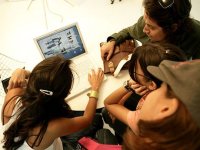How to Integrate Tech When It Keeps Changing
Your content has been saved!
Go to My Saved Content.Asking if technology enhances learning is like asking if dogs are playful. Whether we're discussing tech or those furry mouth-breathers, the answer is the same: it depends on the situation. Here's a better line of inquiry: how do you coordinate knowledge, instructional practices, and technologies in order to positively influence academic achievement?
We can begin to answer this question with the Technological Pedagogical Content Knowledge Framework (TPACK), which conceptualizes the integration of "Pedagogical Content Knowledge (PCK), Technological Content Knowledge (TCK), Technological Pedagogical Knowledge (TPK), and the intersection of all three," explains Dr. Matthew Koehler, editor of tpack.org. Watch (and feel free to share) the "TPACK in 2 Minutes" video below:
Reading about TPACK helps me understand why transforming instruction with technology is slow in many but not all classrooms, a notion articulated beautifully by William Gibson: "The future is already here -- it's just not very evenly distributed." Besides being expensive, meaningful tech integration is just plain complicated.
Meanwhile, those of us whose skills in tech integration are not quite Olympic class may find the SAMR model (Substitution, Augmentation, Modification, and Redefinition) more helpful for locating ourselves along the continuum of maximizing the transformational impact of technology. What won't work is waiting for technological change to stabilize. "The only way to make sense out of change,” said Alan Watts, “is to plunge into it, move with it, and join the dance." The following section discusses how to do just that.
Sensible Technology Integration
By 2015, 80 percent of people accessing the Internet will do so with mobile devices. What other fundamental advances and cultural shifts will come our way? Nobody knows. But here are some guidelines for negotiating those changes:
1. Take Off Your Expert Hat
You'll never keep abreast of every technology innovation, so allow yourself to be a curious learner that doesn't know it all. Give yourself 30 minutes every couple of weeks to learn a new tech tool from Tammy's Technology Tips, Edudemic, Monica Burns' ClassTechTips, Kathy Schrock's Guide to Everything, Cybraryman's Teacher Tools, or Richard Byrne's Favorite Resources. Happy clicking!
2. Get to Know the Standards
Refer to the teaching standards crafted by professional organizations in your discipline, and then make the technology serve those standards and literacies. Let's take interactive white boards (IWBs) in math class as an example. "If children's only interaction with an IWB is to come up one at a time to answer a question," says researcher Sandra Linder, "then it is not being used in the most effective manner." Math lessons that integrate the IWB, she argues, benefit when a lesson follows the processing standards recommended by the National Council of Teachers of Mathematics:
- Building communities and communication
- Making connections
- Representing understanding
- Exploring with materials
- Child-centered tasks.
3. Reach Out to Thought Leaders
To find the best tools for an authentic task, peruse the top education technology bloggers and ask their advice on social media.
4. Interact with Students via Tech
More specifically, use tech to interact with students during their learning. Two years ago, Catlin Tucker, an English teacher at Windsor High School in Sonoma County, California, created short mini-lesson videos -- flipping her writing instruction so that more class time could be used for students to write. In the computer lab, she comments on students' Google Doc drafts in real time as they're being composed. She says, "The time I spend helping my students to edit and refine their writing as they write is exponentially more valuable for them than the final comments I leave on their essays."
5. Read Henry Jenkins
North Carolina educator Jennifer Smyth introduced me to Henry Jenkins' Confronting the Challenges of Participatory Culture: Media Education for the 21st Century. The text identifies a set of core social skills and cultural competencies that young people should acquire in order to read and impact our emerging participatory culture:
- Play: the capacity to experiment with your surroundings as a form of problem solving.
- Performance: the ability to adopt alternative identities for the purpose of improvisation and discovery.
- Simulation: the ability to interpret and construct dynamic models of real world processes.
- Appropriation: the ability to meaningfully sample and remix media content.
- Multitasking: the ability to scan one's environment and shift focus as needed to salient details.
- Distributed Cognition: the ability to interact meaningfully with tools that expand mental capacities.
- Collective Intelligence: the ability to pool knowledge and compare notes with others toward a common goal.
- Judgment: the ability to evaluate the reliability and credibility of different information sources.
- Transmedia Navigation: the ability to follow the flow of stories and information across multiple modalities.
- Networking: the ability to search for, synthesize, and disseminate information.
- Negotiation: the ability to travel across diverse communities, discerning and respecting multiple perspectives, and grasping and following alternative norms.
If your students are developing disciplinary skills and knowledge through these practices, you're on the right track.
For even more information on this topic, visit Edutopia’s Technology Integration Resources. Finally, don't worry about how the flurry of tech revolutions on the horizon will impact your classroom. Harvard psychologist Steven Pinker believes, "Far from making us stupid, these technologies are the only things that will keep us smart."
Tell us your technology integration success stories.
